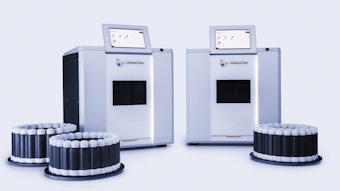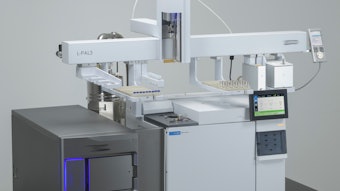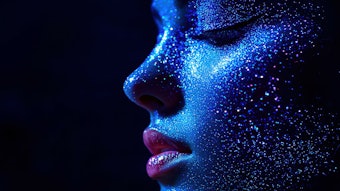
Most personal care formulas comprise a blend of water, emollients and stabilizing agents, but extracts and actives are also added for any number of benefits or claims. Ultimately, the efficacy of these products depends on the efficient transport of their actives to areas where they need to act. For example, emollients need to interact with the uppermost layers of the stratum corneum, but other actives should penetrate into the deeper layers of the skin.
The cosmetic industry has recourse in specialized delivery systems such as liposomes, liquid crystals and other self-organized systems that enhance the uptake of actives. Understanding and visualizing how actives are delivered via these platforms is essential during product development and prior to final product commercialization to provide scientific data in support of a product’s efficacy.
However, assessing the efficacy of these systems is often performed indirectly—i.e., visually observing whether the formulation fulfills its promises. Physical measurements of the skin’s properties also may be used to determine relative variations in wrinkle depth, skin softness or elasticity.
In contrast, direct measurements of an active’s delivery would provide significant advantages for the development and assessment of personal care products. As such, vibrational imaging spectroscopy analytical techniques can be used to rapidly and directly measure key performance attributes associated with cosmetic formulations.
Here, the authors describe techniques to evaluate and visualize the permeation of actives through hair, nails and/or skin. The methods covered include:
Confocal Raman microscopy, a non-invasive technique requiring minimal sample preparation. This method provides excellent spatial resolution and the ability to obtain kinetic information concerning the diffusion of actives through different biomaterials;
Attenuated total reflectance Fourier transform infrared spectroscopy (ATR-FTIR), in imaging mode. This is invaluable to study the deposition and penetration of actives into stratum corneum (SC) layers with the advantages of little sample preparation and higher spatial resolution, compared with conventional infrared (IR) imaging; and
Conventional FTIR imaging, which can provide quantitative depth profiles of actives over a large skin area in a timely manner.
Several studies performed at Textile Research Institute (TRI) Princeton are included in this paper to highlight the ability of these methods to analyze the deposition, delivery and penetration of actives into hair, nails and skin, and to determine the relative efficacy of specific systems to enhance the delivery of actives.
Materials and Methods
Methods: To determine the effects of permeation enhancers, caffeine penetration into skin was investigated by confocal Raman microscopy and ATR-FTIR imaging. Both approaches show the spatial distribution and depth profile for the active and vehicle. In addition, the efficacy of different delivery systems on caffeine penetration into skin, and the penetration of cosmetic actives into hair and nails were investigated.
Materials: Caffeine, propylene glycol (PG) and dimethyl isosorbide (DMI) were purchaseda. Caffeine solutions (~5% w/v) were prepared in PG with and without DMI. Hydrogenated lecithin with caffeine (1%); a standard soya-derived lecithin with caffeine (1%); qusomes (PEG-12 glyceryl dimyristate) with caffeine (1%); and liposomes with caffeine (1%) also were providedb. Human abdominal skin was obtained as a by-product from plastic surgery (otherwise to be discarded) from dermatological offices with informed consent and ethics board approval. Human hair fibers and nail samples were collected internally from volunteers.
Test Protocol for Permeation Enhancers
Confocal Raman imaging: Human skin was treated for ~20 hr at 34°C. After incubation, skin was placed in a brass cell. Images were acquired with a confocal Raman microscope equipped with a 532 nm laserc. XZ images were taken for each sample, whose depths were typically 50 × 40 µm2, covering the SC and upper viable epidermis (VE) region in 2 µm steps and within a 20 sec exposure time.
ATR imaging: Skin was placed on a glass slide with the SC side up. At least two ATR images were acquired as controls before any treatment. The skin was then treated topically for 3 hr at 34°C. After incubation, subsequent tape stripping was performed in order to see product penetration at different layers in the skin sample.
At least two ATR images were taken after the first, second, fourth, sixth and eighth tape strips. IR images were acquiredd in ATR mode. A 6.25 µm pixel size was utilized and four scans were accumulated at a 4 cm-1 spectral resolution; image sizes were typically 300 × 300 µm2, covering a large surface area.
Test Protocol for Delivery Systems
Confocal Raman microscopy: Skin was assembled on a glass slide with a piece of wet paper beneath the dermis. Five to six Z lines from the same site were acquired before treatment, followed by the application of 10 µL of the formulations to the top of the SC and rubbing for 3 min. Repeated Z lines were acquired as a function of time after treatment, for up to 1 hr. The whole sample was kept at 32°C throughout. Each Z line was taken from the surface to a 30 µm depth, at a 2 µm resolution and with a 20 sec exposure time. An 1,800 g/mm grating was utilized for higher spectral sensitivity.
ATR imaging: Skin was treated topically with hydrogenated or standard soya-derived lecithin and incubated at 32°C. At 15 min and 3 hr time points, half of the skin was cleaned and fast-frozen in liquid nitrogen. The frozen skin was then microtomed perpendicular to the skin surface in ~6 µm thick sections and mounted on calcium fluoride windows. ATR-FTIR images were acquired over the skin cross-sections with a spectral resolution of 4 cm-1. Four scans were accumulated at a spatial resolution of 1.55 µm. Typical image sizes were 400 × 200 µm2, covering a large part of the SC and the epidermis.
Test Protocol for Hair and Nail Penetration
ATR imaging, hair: Resorcinol is a common ingredient for hair care, especially in coloring and bleaching products. Thus, human virgin hair was soaked in a 10% resorcinol solution for 5 min, 30 min or 60 min. After treatment, each hair sample was microtomed in ~4 µm thick sections and mounted on IR windows. IR images were acquiredd in transmission mode at a spectral resolution of 4 cm-1 and four scans were accumulated at a spatial resolution of 6.25 µm.
ATR imaging, nails: Human nail samples were treated with a commercial nail polish (brand X). Two layers were applied to ensure an integral coating on the nail surface. After product application, the treated nails were examined at 4 hr and 24 hr. For each time point, nail cross-sections were prepared with a cryostat using a sectioning method developed in the TRI Princeton laboratory. The nail cross-sections were analyzed by ATR-FTIR imaging spectroscopy using 1.55 μm spatial resolution at 4 cm-1 spectral resolution and four accumulated scans.
Results: Permeation Enhancers by Confocal Raman
Overlaid Raman spectra of single components and formulations in PG, with and without DMI, are shown in Figure 1a. Overlaid Raman spectra of untreated skin, skin treated with 5% caffeine and the Raman contribution of the caffeine alone are displayed in Figure 1b. After comparing these spectra, the peaks around 557 cm-1 and 1,343 cm-1 were used as specific markers for the caffeine, and the peak around 844 cm-1 was used as marker for PG.
The relative concentration of caffeine was quantified by the intensity peak ratio between the 557 cm-1 or 1,343 cm-1 bands, and the Amide I band at 1,656 cm-1. The relative concentration of PG was analyzed by the intensity peak ratio between the band at 844 cm-1 from the PG, and the Amide I peak at 1,656 cm-1.
Vibrational imaging spectroscopy can be used to directly measure key cosmetic performance attributes.
Confocal Raman images showing the relative concentration of caffeine and vehicle inside different skin samples are presented in Figure 2. These images allow for the analysis and visualization of the spatial distribution of the exogenous agents in the different skin layers. The scale is color-coded, with the dark red representing the highest content of caffeine and the dark blue representing the lowest content of caffeine. Untreated samples were used as control and as expected, no caffeine or PG was detected in these samples.
Skin samples were treated with two different formulations containing 5% caffeine in a Franz cell for 20 hr. These duplicate experiments showed caffeine from the formulation based on PG alone only penetrated ~8-14 µm into skin, whereas caffeine penetrated deeper (~16-30 µm) (see Figure 2a and Figure 2b) from the formulation containing both PG and DMI. This data clearly showed the DMI improved the penetration of caffeine.
When the spatial distribution of the caffeine (see Figures 2a-b) and the PG (see Figure 2c) are compared in samples treated without DMI, caffeine and PG were co-localized in the same skin areas. Some inclusions of caffeine and PG were clearly observed (see dashed white lines in Figure 2), and the locations of those inclusions corresponded to each other.
Note the caffeine penetrated only into the SC region—the green dashed line delineates the skin surface, SC and the VE—and its penetration was non-uniform. In the samples treated with DMI, the co-localization between the caffeine and the PG was still obvious but the caffeine distribution was more homogenous throughout the SC and clearly reached into the upper layer of the VE.
In conclusion, DMI significantly improved the penetration of caffeine more deeply into the skin. This penetration also was observed to be more homogenous.
Results: Permeation Enhancers by ATR Imaging
IR spectra recorded on single components and on the two different caffeine formulations, with and without DMI, are shown in Figure 3a; Figure 3b shows overlaid IR spectra of untreated skin (green), skin treated with 5% caffeine (blue) and the IR contribution of the caffeine alone (red). One of the most intense bands of caffeine, arising as a shoulder on the Amide I band at 1,698 cm-1, was used as the marker to detect the caffeine inside skin samples. The relative concentration of caffeine was assessed using the 1,698 cm-1 to Amide I intensity peak ratio.
ATR-FTIR images showing the relative caffeine concentration penetration are shown in Figure 4. The images are color coded, where the dark red represents the highest caffeine content and the dark blue represents the lowest or no caffeine content. The images of the skin recorded before the treatment were used as baseline.
For both treatments, caffeine was detected right after treatment and at the second tape stripping. After the fourth tape strip, samples treated without DMI showed a dramatic decrease in caffeine content, whereas samples treated with DMI presented a more homogenous distribution of caffeine even after the sixth and eighth tape strip.
This IR data is consistent with the results recorded using the confocal Raman method and show that the DMI significantly enhanced the penetration of caffeine into the SC.
Results: Delivery Systems by Confocal Raman
For each separate experiment in this series, all Z lines recorded at different time points were concatenated to construct a “kinetic image” per treatment. These images were further concatenated into one large image in order to compare the caffeine penetration profile associated with the four different delivery systems tested: qusomes, hydrogenated lecithin, liposomes and standard soya-derived lecithin.
The relative concentration of the caffeine was investigated by measuring the peak area ratio between the caffeine band at 560 cm-1 (see Figure 5a) or 744 cm-1 (see Figure 5b) and the phenylalanine peak area at 1,003 cm-1. Again, the dark red represents the highest concentration and the dark blue represents the lowest concentration of caffeine.
As expected, in the untreated skin samples, no caffeine contribution was detected. The liposome and standard soya-derived lecithin allowed the caffeine to penetrate significantly deeper (~15-25 µm), and the penetration of the caffeine was strongly correlated with the treatment time. The caffeine penetration was the fastest with the soya-derived lecithin.
After 1 hr of treatment, the qusomes did not assist caffeine in penetrating the SC. The hydrogenated lecithin, on the other hand, was an effective but slow delivery system; i.e., caffeine was delivered significantly into the skin but its presence did not appear until after 45 min of treatment.
These kinetic images could be useful to compare different delivery systems in formulas, as they provide interesting information about the kinetics of actives release inside the skin—i.e., slow or fast.
Results: Delivery Systems by ATR-FTIR Imaging
The kinetics of caffeine penetration also were investigated by ATR imaging on skin cross-sections (see Figure 6). Here, the relative content of caffeine in skin is shown after the topical application of two different formulas: hydrogenated lecithin and standard soya-derived lecithin. FTIR images were generated by measuring the peak intensity ratio between the caffeine band at 1,698 cm-1 and the Amide II band. The images, again, are color-coded, where the dark red represents the highest caffeine concentration and the dark blue represents the lowest caffeine concentration.
As expected, no caffeine was detected in the untreated skin controls. After a 15 min treatment, skin treated with the standard soya-derived lecithin showed a higher concentration of caffeine—i.e., more intense red regions, compared with the hydrogenated lecithin; it also showed deeper delivery. This data is consistent with the Raman data.
DMI significantly improved the penetration of caffeine more deeply into skin. This penetration also was observed to be more homogenous.
After a 3 hr treatment, the skin treated with soya-derived lecithin also presented with a higher concentration and more homogenous distribution of caffeine. However, the penetration did not reach deeper into the skin layers. The caffeine penetrated ~20-30 µm, which correlates with the confocal Raman measurement. The main difference observed was in skin treated with hydrogenated lecithin. After 3 hr, the caffeine was delivered in significantly higher levels and significantly deeper into skin. The distribution after 3 hr also was more homogeneous than observed after 15 min.
This finding confirms the Raman data and illustrates that the delivery system based on hydrogenated lecithin released the caffeine more slowly, compared with the standard soya-derived lecithin.
Results: Resorcinol Into Human Hair
As noted, to visualize the penetration of exogenous components inside hair fibers, virgin hair tresses were soaked in a 10% resorcinol solution for 5 min, 30 min or 60 min. After each treatment time, hair cross-sections were prepared and analyzed by FTIR imaging spectroscopy. FTIR images showing the relative content of resorcinol inside the hair fibers are shown in Figure 7. Once again, the images are color-coded; the dark red corresponds to the highest resorcinol content and the dark blue corresponds to the lowest resorcinol content.
As expected, in the control samples, no resorcinol was observed. After a 5 min treatment, resorcinol presented at the surface and inside the cuticles. With longer treatment times, the deposition of resorcinol at the surface increased and the resorcinol penetrated inside the cortex.
Experiments such as these can determine the dose response or correct treatment time necessary for an active to penetrate hair fibers.
Results: Nail Polish into Human Nails
Overlaid FTIR spectra recorded from virgin and polish-treated nails are shown in Figure 8a. The C=O stretching band at 1,738 cm-1 was used as the IR marker to follow the penetration of the nail polish. A visible image of the nail cross-section is shown in Figure 8b-1. The associated IR images showing the protein content and nail polish content are shown in Figures 8b-2 and 8b-3. These figures highlight the capability of monitoring both exogenous and endogenous components at the same time.
Penetration of the nail polish into the nail was monitored by ATR-FTIR imaging (see Figure 9). Again, these images are color-coded; the dark red corresponds to the highest nail polish content and the dark blue corresponds to the lowest nail polish content inside the nail samples.
As expected, no product was detected in the untreated nail sample. The penetration of some components from the nail polish in the nail samples was clearly observed after 4 hr and 24 hr of treatment. The penetration presents a gradient of concentration from the nail surface to the inside. The active penetration goes deeper into the nail treated for 24 hr.
It is interesting to note the penetration was non-uniform inside the nail sample. After 4 hr, the penetration was limited to the first 60 μm under the nail surface. After 24 hr, although not homogeneous, the active crossed the entire nail.
This study focused mainly on the active penetration; however other parameters could be extracted from these Raman or IR images such as the hydration level or the structural organization of the protein. This data could be correlated together to investigate the potential effects of the active upon penetration into a biomaterial.
Discussion
The delivery of caffeine inside skin samples was measured in the presence and absence of the permeation enhancer DMI. Clearly, both ATR-FTIR and confocal Raman imaging visually highlighted the benefits of using the enhancer to improve the delivery of the active into skin. In fact, the distribution of the caffeine was more homogenous and reached deeper into the skin layers (VE) with DMI.
Similarly, the release of caffeine was compared among four different delivery systems. Caffeine (1%) was loaded into different liposomes prepared with various chemistries: PEG-12 glyceryl dimyristate, hydrogenated lecithin, phospholipids and lecithin. These liposomes were prepared by adding caffeine to the emulsifier, adding water and subjecting them to ultrasonic dispersion.
The results presented a broad range of release profiles. The penetration of caffeine into skin was highest in the presence of lecithin and almost absent in the case of the PEG-12 glyceryl dimyristate. The phospholipids and hydrogenated lecithin both enabled moderate uptake profiles. It also was possible to discriminate between the different delivery systems in terms of release speed; the hydrogenated lecithin release caffeine more slowly than standard, soya-derived lecithin.
This work shows that different delivery systems present specific benefits to enhance the delivery of actives. Moreover, vibrational imaging spectroscopy in general showed strong potential to optimize and compare product formulations. Given the wide choice of formulation agents at the chemists’ disposal, the final decision is often left to economic and availability factors rather than performance. The use of an uptake measurement, however, removes all guesswork from the development process and enables the preparation of the finest possible product that will perform as intended.
Conclusions
This paper demonstrates the feasibility of utilizing vibrational imaging spectroscopy to probe, compare and visualize the penetration of cosmetic actives into skin, hair and nails. These techniques can provide a direct measurement of the efficacy of chemical penetration enhancers, as well as different delivery systems. They also have the potential for wide application in the cosmetics and personal care industry, to understand the mechanisms of formulations or assess their efficacy.
While not strictly addressed in this study, molecular and structural parameters such as levels of hydration, lipid organization inside the stratum corneum (in associated with barrier function) and structural information about protein (e.g., collagen or keratin) also could be investigated using these techniques. Finally, these methods are extremely relevant for marketing purposes because they provide imagery that visually supports product claims for penetration, retention, long-lasting effects, moisturization and skin barrier integrity.











